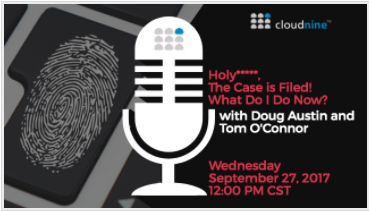Want Some Tips on How to Prepare for the Rule 26(f) Meet and Confer? Join us Today!: eDiscovery Best Practices
Not only are the first days after a complaint is filed critical to managing the eDiscovery requirements of the case efficiently and cost-effectively, you need to do some prep even before the case is filed. With a scheduling order required within 120 days of the complaint and a Rule 26(f) “meet and confer” conference required at least 21 days before that, there’s a lot to do and a short time to do it. Where do you begin? Find out today!
But first, I’m excited to report that eDiscovery Daily has been nominated to participate in The Expert Institute’s Best Legal Blog Contest in the Legal Tech category! Thanks to whoever nominated us! If you enjoy our blog, you can vote for it and help it win a spot in their Best Legal Blogs Hall of Fame. You can cast a vote for our blog here. Thanks!
Anyway, today at noon CST (1:00pm EST, 10:00am PST), CloudNine will conduct the webcast Holy ****, The Case is Filed! What Do I Do Now? (yes, that’s the actual title). In this one-hour webcast, we’ll take a look at the various issues to consider and decisions to be made to help you “get your ducks in a row” and successfully prepare for the Rule 26(f) “meet and confer” conference within the first 100 days after the case is filed. Topics include:
- What You Should Consider Doing before a Case is Even Filed
- Scoping the Discovery Effort
- Identifying Employees Likely to Have Potentially Responsive ESI
- Mapping Data within the Organization
- Timing and Execution of the Litigation Hold
- Handling of Inaccessible Data
- Guidelines for Interviewing Custodians
- Managing ESI Collection and Chain of Custody
- Search Considerations and Preparation
- Handling and Clawback of Privileged and Confidential Materials
- Determining Required Format(s) for Production
- Timing of Discovery Deliverables and Phased Discovery
- Identifying eDiscovery Liaison and 30(b)(6) Witnesses
- Available Resources and Checklists
I’ll be presenting the webcast, along with Tom O’Connor, who is now a Special Consultant to CloudNine! If you follow our blog, you’re undoubtedly familiar with Tom as a leading eDiscovery thought leader (who we’ve interviewed several times over the years) and I’m excited to have Tom as a participant in this webcast! To register for it, click here. Even if you can’t make it today, go ahead and register to get a link to the slides and to the recording of the webcast (if you want to check it out later).
So, what do you think? When a case is filed, do you have your eDiscovery “ducks in a row”? Please share any comments you might have or if you’d like to know more about a particular topic.

Disclaimer: The views represented herein are exclusively the views of the author, and do not necessarily represent the views held by CloudNine. eDiscovery Daily is made available by CloudNine solely for educational purposes to provide general information about general eDiscovery principles and not to provide specific legal advice applicable to any particular circumstance. eDiscovery Daily should not be used as a substitute for competent legal advice from a lawyer you have retained and who has agreed to represent you.







